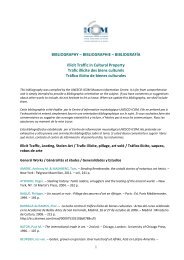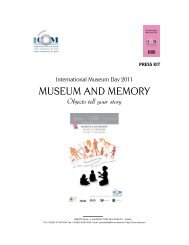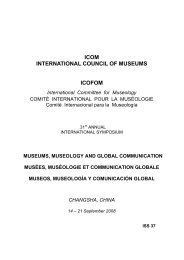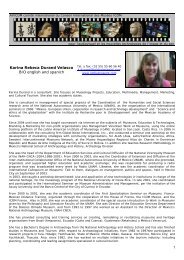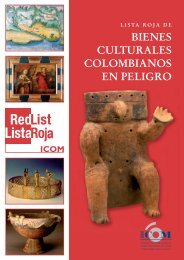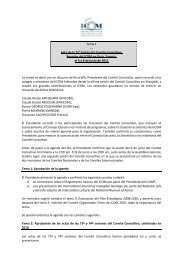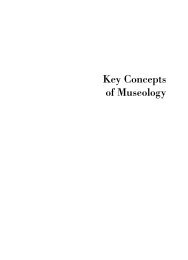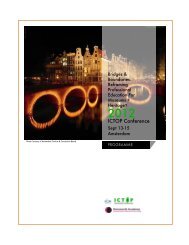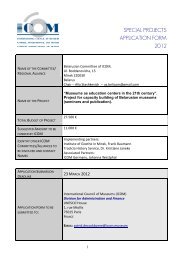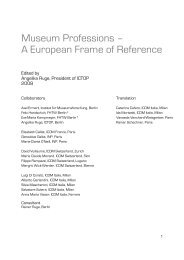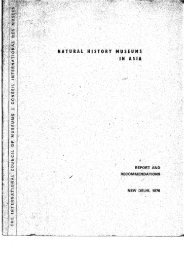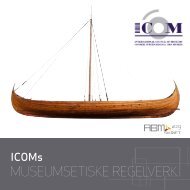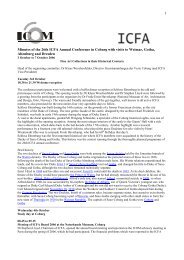ISS 25 (1995).pdf - The International Council of Museums
ISS 25 (1995).pdf - The International Council of Museums
ISS 25 (1995).pdf - The International Council of Museums
You also want an ePaper? Increase the reach of your titles
YUMPU automatically turns print PDFs into web optimized ePapers that Google loves.
with its various departments. Thomsen's foremost preoccupaoon was me<br />
prehistoric collection, which was the subject for discussion <strong>of</strong> a Royai<br />
cOmmission formed in 1807, where Thomsen became the ;ecretary in 1816.<br />
In 1820 another commission started to work with the distribution to new<br />
specialized museums <strong>of</strong> the collections in the old Royal Cabinet <strong>of</strong> Curiosities,<br />
to which Worm's collection had been previously added. but which was now<br />
considered outdated. Thomsen participated in bringing the pictures to the<br />
new National Museum <strong>of</strong> Art established in 1839. <strong>The</strong> ethnographic objects<br />
formed the core <strong>of</strong> the Ethnographic Museum opened two years later as the<br />
first in the world. In 1861 Thomsen became the director <strong>of</strong> the whole<br />
National Museum complex. Like Worms, Thomsen corresponded widely with<br />
colleagues all over Scandinavia and he was a sought for advisor on museum<br />
issues. Thus he had a strong influence on the arrangement <strong>of</strong> the Swedish<br />
prehistoriC collections which were now at last taken care <strong>of</strong> in a proper way.<br />
From the century also the famous Thorvaldsen-museum (1848) and the<br />
Carlsberg Glyptotek (1888) date.<br />
An equally important contribution was towards the end <strong>of</strong> the century made<br />
by Artur Hazelius in Sweden. In his university years he had eagerly<br />
participated in the scandinavistic manifestations and at the same time his<br />
studies <strong>of</strong> Old Norse and Swedish dialects kindled by the nationalistic<br />
romanticism reigning in the humanistic studies <strong>of</strong> the day had made him<br />
a.,.,=e <strong>of</strong> the swiftly disappearing traditional culture <strong>of</strong> the provinces. This<br />
combined to inspire his project <strong>The</strong> Scandinavian Ethnographic Collections<br />
which he brought together, arranged and opened as an exhibition in the<br />
centre <strong>of</strong> Stockholm in 1873. This collection became the nucleus <strong>of</strong> the later<br />
Nordiska Museet, whose completion Hazelius himself however did not live to<br />
see. But his name is first <strong>of</strong> all linked to Skansen, the open-air museum<br />
inaugurated 1891 in Stockholm. His idea was to create a museum, where the<br />
objects were integrated in their proper surrounding, not only in a genuine<br />
building, but in the complete farmstead with all buildings belonging to it<br />
ana with the original surrounding <strong>of</strong> cultivated ground reconstructed. And<br />
in the buildings, among the objects the visitor should have the opportunity<br />
to meet people al horne in the culture which the farmstead represented.<br />
Hazeliu; ha; been honoured as the inventor <strong>of</strong> the open air-museum<br />
concept. But this is a truth which has been challenged. in the South <strong>of</strong><br />
Sweden, at Lund, Georg Karlin was in the same years busy with similar<br />
plans. In Norway a number <strong>of</strong> persons had the idea to save specimens <strong>of</strong> the<br />
extraordinary material culture both in wooden objects and timber<br />
architecture, foremost among them Anders Sandtvig founder <strong>of</strong> Maihaugen<br />
in Lillehamrner and Hans Jacob Aall founder <strong>of</strong> Norsk Folkemuseum. In<br />
Denmark l3ernhard Olsen, founder <strong>of</strong> the Danish Folk Museum, inspired both<br />
by Karlin and Haze1ius but also by a visit to the World Exhibition <strong>of</strong> 1878 in<br />
Paris, could open his Open Air Museum in Lyngby close to Copenhagen in<br />
1901. Although the question <strong>of</strong> original authorship may be controversial,<br />
the open-air museum concept seems to be a genuine Scandinavian<br />
phenomenon. In the writings <strong>of</strong> both Marc Bloch and George Henri Riviere<br />
we can see this certified as also its importance for the later shaping <strong>of</strong><br />
Riviere's museological concepts.<br />
<strong>The</strong> 19th century was permeated with nationalistic ideas. And in Finland and<br />
Norway the nationalistic ideas kindled an opposition against the dependence<br />
on Swedish and Danish <strong>of</strong>ficial culture and we can witness its expression in<br />
museum projects. As a reaction on the Royal Commission <strong>of</strong> 1807 in<br />
Copenhagen, Norwegians began the formation <strong>of</strong> an archaeological<br />
collection <strong>of</strong> their own began, which was located in the university recently<br />
organised in Oslo. At the same time museum- plans were developed in Bergen<br />
- with British Museum in London as a model. In Iceland its National museum<br />
182



